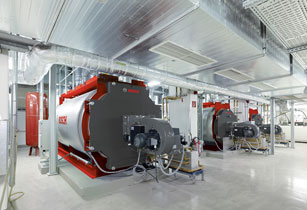?Modern? steam boilers can save energy as well as money, according to Bosch Industrial
Bosch Industrial has provided its expertise to modernise a steam boiler of a company.
The boiler with an output of four tonnes of steam per hour had been supplying the process steam since 1978.
According to the company, energy efficiency and cost-reduction in production facilities has become vital for competitive production and increased profitability. Either existing old boiler can be modernised or a complete new system can be tailor-made adapted to match these needs.
An expert support is, however, needed during the new purchase or modernisation phase.
In the boiler, an economiser was retrofitted to ensure efficient use of the flue gases, which can reach temperatures of as much as 230?C. The boiler feed water was preheated while the flue gas temperature was reduced by around 100?C. The boiler efficiency was increased by a reduction in flue gas losses of approximately five per cent; similarly, fuel consumption was reduced at full load.
To boost efficiency levels even further, the existing light oil burner was replaced with a state-of-the-art dual burner. Natural gas is used as the main fuel and light fuel oil is only used during peak load operation or in an emergency.
To ensure correct dosing of the fuel/air ratio, an electronic combined control was included. In the old burner, the combined control was a mechanical type. As time passes and machinery ages, the wear exerted on mechanical components creates an increasingly high level of backlash (hysteresis), which means that more excess air is required. As a result, an unnecessary high amount of cold air is heated. This reduces efficiency levels. Using a firing with electronic combined control, however, enabled the excess air level to be set with greater precision, which in turn creates savings.
In addition, the new firing enabled infinite variable operation with a turndown ratio of 1:5 during gas operation. The previous oil burner was only able to achieve a turndown ratio of 1:2. Consequently, the burner adapted itself much more readily to actual steam requirements. If, for example, just 30 per cent of the steam quantity was required instead of the nominal load, the burner output was reduced.
In the old burner?s case, this kind of output reduction led to pulsating burner operation.
This resulted in a sequence of events where the firing mechanism was switched off , pre-ventilation was carried out with corresponding energy losses, the firing mechanism was switched back on and then, a short time later, switched off again.
The fan motor of the old burner was operated at a constant speed and the air damper varied the air quantity. The new burner regulated the motor speed of the fan in relation to the burner capacity. The electrical power consumption in the partial load range was considerably lower and at the same time there was also a significant reduction in the sound pressure level. Even the oxygen content in the flue gas was continually recorded. If it was too high, making combustion ineffective, the volume of combustion air was reduced. As a result, there was no need for increased levels of excess air, as is required in conventional systems. The oxygen regulationm, thus, optimised the efficiency of the burner system, reduces its environmental impact, and helps to save energy costs.
Bosch Industrial experts are of the opinion that the process of optimising systems requires in-depth analyses before any work is actually carried out.
The new integrated BCO boiler control comes with all the necessary information and functions for ensuring that operation is optimized and carried out on the basis of need. A touch screen display allows a wide range of information such as operating states, operating data and measured values to be displayed.
Implementation phases of the modernisation measures
? Retrofitting an economiser
? Replacing the oil burner with a modulating dual burner
? Use of energy-saving speed regulation
? Combustion-optimising control that monitor the remaining oxygen content in the flue gas
? Optimising the system control method by bringing a modern, programmable control into play
The result: Annual cost savings US$50,000
Thanks to the measures mentioned above, a reference project was able to reduce the energy consumption of the system by approximately 90MWh per year. The modernisation and switch to natural gas can save the facility around US$50,000 in running costs per year. The return on investment is 40 per cent. In addition, the CO2 emissions are reduced by 21 tonnes per year.






